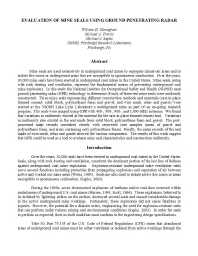Mining Publication: Evaluation of Mine Seals Using Ground Penetrating Radar
Original creation date: March 2005
Mine seals are used extensively in underground coal mines to segregate mined-out areas and to isolate fire zones or underground areas that are susceptible to spontaneous combustion. Over the years, 30,000 mine seals have been erected in U.S. underground coal mines. Mine seals, along with rock dusting and ventilation, are the fundamental means of preventing underground coal mines explosions. In this study, NIOSH used ground penetrating radar (GPR) technology to determine if each of three test mine seals was uniformly constructed. Three mine seals representing different construction methods and materials (cast-in-place foamed cement; solid-block, polyurethane foam, and gravel; and wire-mesh, rebar, and gunite) were erected at the NIOSH Lake Lynn Laboratory's underground mine as part of an ongoing research program. The seals were imaged using GPR with 400-, 500-, 900-, and 1,000-MHz antennas. We found that variations in uniformity existed in the material for the cast-in-place foamed cement seal. Variations in uniformity also existed in the seal made from solid block, polyurethane foam, and gravel. The post-processed radar records correlated closely with recovered core samples (areas of gravel and polyurethane foam, and areas containing only polyurethane foam). Finally, the radar records of the seal made of wire mesh, rebar, and gunite showed the various components. The results of this work suggest that GPR could be used as a tool to evaluate mine seal characteristics and construction uniformity.
Authors: WD Monaghan, MA Trevits, MJ Sapko
Conference Paper - March 2005
NIOSHTIC2 Number: 20026679
Proceedings of the Symposium on the Application of Geophysics to Engineering and Environmental Problems (SAGEEP 2005), Atlanta, Georgia, April 3-7, 2005. Denver, CO: Environmental and Engineering Geophysical Society, 2005 Apr; :1-14
See Also
- Application of Ground Penetrating Radar to Evaluate the Extent of Polyurethane Grout Infiltration for Mine Roof Control: A Case Study
- Assessment of Technology for Non-destructive Testing of In-situ Underground Mine Seals
- Clearing the Air
- Comparison of Methods: Dynamic Versus Hydrostatic Testing of Mine Ventilation Seals
- Experimental Mine and Laboratory Dust Explosion Research at NIOSH
- Explosion Pressure Design Criteria for New Seals in U.S. Coal Mines
- Progress Toward Improved Engineering of Seals and Sealed Areas of Coal Mines
- Structural Analysis and Design of Seals for Coal Mine Safety
- Technical Solutions for Enhancements to Mine Safety Using Barricade II Fire Blocking Gel
- Use of Ground Penetrating Radar and Schmidt Hammer Tests to Determine the Structural Integrity of a Mine Seal
- Page last reviewed: 9/21/2012
- Page last updated: 9/21/2012
- Content source: National Institute for Occupational Safety and Health, Mining Program


 ShareCompartir
ShareCompartir
